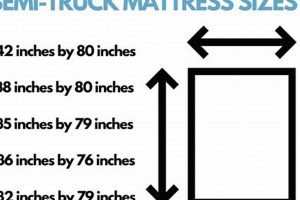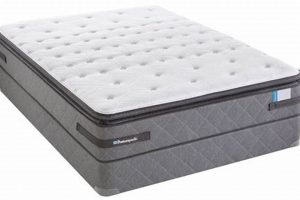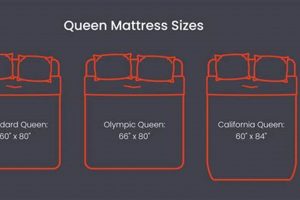A cot mattress, typically found in nurseries or smaller sleeping spaces, requires specific dimensions for safety and proper fit within the cot frame. Standard dimensions generally fall within a range suitable for infants and toddlers, ensuring secure placement and preventing gaps that could pose a risk. For example, a typical cot mattress might measure approximately 27 inches wide by 52 inches long in some regions, whereas measurements may vary according to different regional standards.
Adherence to appropriate measurements offers several benefits. A properly sized mattress ensures the occupant’s safety by preventing entrapment between the mattress and the cot frame. Furthermore, a secure fit contributes to the overall comfort of the sleeping environment. Historically, cot dimensions have evolved alongside safety regulations to provide optimal sleeping conditions for young children.
The subsequent sections will delve into specific dimensional standards, variations across different cot types, and considerations when selecting a mattress to ensure a secure and comfortable sleeping environment for the child occupant.
Cot Mattress Dimension Considerations
Proper selection of a cot mattress involves careful attention to dimension. The following tips provide guidance on ensuring a secure and appropriate fit.
Tip 1: Consult Manufacturer Specifications: Always refer to the cot frame’s manufacturer specifications before purchasing a mattress. Dimensions may vary, and adherence to these guidelines is crucial for safety.
Tip 2: Measure Interior Cot Dimensions: Independently measure the interior length and width of the cot frame. This provides a baseline against which to compare potential mattresses and confirms accuracy.
Tip 3: Prioritize a Snug Fit: Aim for a snug fit between the mattress and the cot frame. Gaps exceeding the width of two fingers can pose a safety hazard.
Tip 4: Consider Mattress Thickness: Mattress thickness affects the overall height within the cot. Ensure sufficient rail height remains above the mattress surface to prevent climbing out.
Tip 5: Account for Mattress Compression: New mattresses may compress slightly after initial use. Factor this potential compression into the fit assessment.
Tip 6: Verify Compliance with Safety Standards: Confirm that the mattress meets relevant safety standards. These standards often include dimensional requirements.
Adhering to these tips promotes a safe and comfortable sleep environment. Correct mattress dimensions minimize the risk of entrapment and contribute to the overall well-being of the cot’s occupant.
The subsequent section will address specific mattress types and materials suitable for cot use.
1. Length specifications
Length specifications are a fundamental component defining the dimensions of a cot mattress. Precise length is essential to ensuring the mattress fits securely within the cot frame. If the length is too short, gaps appear, presenting a potential entrapment hazard for infants. Conversely, a length that exceeds the frame dimensions may lead to mattress compression or bowing, reducing comfort and potentially compromising structural integrity. As an illustrative instance, a cot designed to accommodate a 52-inch long mattress will present safety concerns if fitted with a 50-inch mattress, requiring accurate measurement to avoid such discrepancies.
Accurate adherence to the specified length also has practical implications for sheet fitting and overall usability. An improperly sized mattress, due to length discrepancies, can make it difficult to secure bedding, increasing the likelihood of loose fabric posing a suffocation risk. For example, ill-fitting sheets can become bunched and dislodged during a child’s sleep, presenting a hazard that is mitigated by a correctly sized mattress with appropriate length dimension. Furthermore, compliance with regulatory standards for cot mattress construction frequently includes explicit length tolerances, underscoring its critical role in safety assessments.
In summary, the specified length is an inseparable element of the overall dimensions of a cot mattress. It directly influences safety by preventing entrapment, contributes to practical usability by ensuring proper bedding fit, and is often a key aspect of regulatory compliance. Therefore, understanding and adhering to the specified length is crucial when selecting a mattress to ensure a safe and comfortable sleeping environment. Deviations present considerable risk, highlighting the importance of accurate measurement and careful selection.
2. Width requirements
Width requirements represent a critical dimension in determining the correct size of a cot mattress. The width directly affects how securely the mattress fits within the cot frame. Insufficient width leads to gaps between the mattress edge and the cot sides, creating a potential hazard where an infant’s limb or head could become entrapped. Conversely, excessive width can cause the mattress to buckle or compress against the frame, leading to discomfort and potentially damaging the cot structure. For example, if a cot frame has an interior width of 27 inches, the mattress must closely approximate this dimension to maintain a safe and secure fit. Deviation from this width specification increases the risk of injury.
The practical significance of understanding width requirements extends beyond mere safety considerations. A correctly sized mattress provides a stable and consistent sleep surface. This is essential for proper spinal alignment and overall comfort. An improperly fitted mattress, due to incorrect width, may contribute to restless sleep or even physical discomfort for the infant. Furthermore, consistent width standards simplify the process of selecting appropriately sized bedding. Sheets and mattress protectors are designed to fit mattresses conforming to established width specifications, reducing the likelihood of improper fit and potential hazards associated with loose or ill-fitting bedding.
In summary, width requirements are an indispensable element in determining the correct size of a cot mattress. Adherence to precise width specifications is not merely a matter of convenience but a critical factor in ensuring the safety, comfort, and overall well-being of the infant. Selecting a mattress that meets or closely approximates the cot’s internal width dimensions minimizes the risk of entrapment, contributes to a stable sleep surface, and simplifies the selection of appropriately sized bedding. Failure to consider width requirements can have detrimental consequences, underscoring the necessity of careful measurement and informed selection.
3. Thickness tolerances
Thickness tolerances, regarding a cot mattress, represent the permissible range of variation from a specified ideal thickness. These tolerances are inextricably linked to the overall size of the mattress, because they influence the safety and functionality of the cot. Exceeding the maximum thickness tolerance can reduce the distance between the top of the mattress and the cot rail, increasing the risk of a child climbing out. Conversely, falling below the minimum thickness tolerance may compromise comfort and support, potentially affecting the child’s spinal alignment. For instance, a cot designed for a 6-inch thick mattress with a +/- 0.5-inch tolerance would be unsafe if fitted with a 7-inch mattress, as the reduced rail height could lead to falls. The correct thickness, within specified tolerances, is thus an essential component of a safe and properly sized cot mattress.
Adherence to thickness tolerances directly impacts the practical use of the cot. Overly thick mattresses can make it difficult to tuck in bedding securely, increasing the risk of loose blankets that can pose a suffocation hazard. Furthermore, excessive thickness can strain the cot frame, potentially leading to structural damage over time. Conversely, a mattress that is too thin may not provide adequate support, potentially leading to discomfort and restless sleep. Proper thickness, within established tolerances, ensures that bedding fits correctly, the cot frame remains structurally sound, and the child receives adequate support for comfortable and safe sleep. Regulatory bodies and manufacturers specify these tolerances to provide clear guidelines for mattress production and selection.
In summary, thickness tolerances are not merely an ancillary detail, but a critical dimension of a cot mattress size. They directly influence safety by affecting rail height and comfort by influencing support. Understanding and adhering to established thickness tolerances is thus a fundamental aspect of selecting a cot mattress that is both safe and functional. Challenges arise when tolerances are not clearly specified or when consumers fail to account for these tolerances when making a purchase. The relationship between thickness tolerances and the overall size of the cot mattress highlights the need for clear communication and careful consideration to ensure a safe and comfortable sleep environment.
4. Frame compatibility
Frame compatibility is paramount when considering the size of a cot mattress. It ensures the mattress fits securely within the cot structure, thereby mitigating safety hazards and optimizing the sleeping environment. Incompatibility can lead to potential risks and discomfort for the infant.
- Dimensional Alignment
Dimensional alignment is the foundational element of frame compatibility. Mattress dimensions (length, width, and thickness) must correspond precisely with the interior dimensions of the cot frame. Discrepancies, even marginal ones, can create gaps that pose entrapment risks for infants. For example, a mattress that is marginally narrower than the frame can create a space where a limb could become wedged. Similarly, a mattress of excessive thickness might compromise the designed safety rail height. Strict adherence to the manufacturer’s specifications for both cot and mattress dimensions is, therefore, necessary to ensure proper dimensional alignment.
- Support Structure Integration
The cot frames support structure, whether slats, a solid base, or springs, is designed to accommodate a mattress of a specific size and weight distribution. Mismatched mattresses can either damage the support structure or receive inadequate support themselves, creating uneven sleeping surfaces or increasing the risk of collapse. For instance, a heavy memory foam mattress may overwhelm a cot frame designed for a lighter, thinner innerspring mattress. Assessment of the cot’s support capacity and matching it to the mattress type is a critical component of achieving proper frame compatibility. A frame not equipped to support the mattress can lead to sagging, creating an unsafe sleep environment.
- Edge Support Synergy
Edge support refers to the structural reinforcement along the perimeter of the mattress, preventing sagging and maintaining a consistent sleeping surface. Frame compatibility influences the effectiveness of edge support. If a mattress is too small for the frame, the edges may lack the necessary support, leading to premature wear and tear and compromising the mattress’s structural integrity. Consider a scenario where the cot sides do not make contact with the mattress edge. This can cause instability, especially as the child grows and begins to move around more within the cot. Adequate frame contact is vital to ensuring that edge support functions as intended.
- Material Interaction
The materials used in both the cot frame and mattress can influence their compatibility. Some materials may react negatively to others, leading to premature degradation or the release of harmful substances. For example, certain mattress materials might interact unfavorably with specific cot frame finishes, potentially causing discoloration, material breakdown, or the emission of volatile organic compounds (VOCs). A careful examination of material composition and potential interactions is advisable to ensure long-term safety and performance.
These facets are intrinsically linked to the appropriate selection of the size of a cot mattress. The ideal size ensures dimensional alignment, integrates seamlessly with the support structure, allows for synergy with the edge supports, and avoids unwanted material interactions. By carefully considering these aspects of frame compatibility, it becomes possible to provide a secure and comfortable sleeping environment.
5. Safety standards
Safety standards directly influence the determination of cot mattress dimensions. These standards, often mandated by regulatory bodies, prescribe acceptable ranges for length, width, and thickness to minimize risks of infant injury or death. For instance, standards dictate maximum allowable gaps between the mattress and cot frame sides, typically specifying that a gap should not exceed a dimension that could entrap a limb or head. Failure to adhere to these standards increases the probability of entrapment, suffocation, or falls. Therefore, safety standards function as a cause, directly shaping the effect specific dimensional requirements for the mattress.
The importance of safety standards as a component in defining the appropriate size of a cot mattress cannot be overstated. These standards reflect accumulated knowledge regarding potential hazards associated with cots and mattresses. They represent a proactive effort to engineer safer products. Real-life examples include cases where non-compliant mattresses led to infant deaths due to entrapment. Such tragic incidents have prompted stricter regulations and greater emphasis on adherence to established safety protocols. The practical significance of understanding these standards lies in ensuring that caregivers can make informed purchasing decisions, prioritizing products that meet stringent safety benchmarks.
In summary, safety standards are foundational in determining the correct size of a cot mattress. They serve as the primary driver in defining dimensional requirements to prevent injuries and fatalities. Challenges persist in enforcing these standards globally and ensuring consistent compliance. However, the overarching goal remains to provide a safe sleeping environment for infants, and adherence to established safety standards represents a crucial step toward achieving this objective.
6. Regional variations
Regional variations exert a tangible influence on cot mattress dimensions. Disparities in accepted manufacturing practices, historical standards, and regulatory frameworks across different geographic regions directly result in deviations in typical cot and mattress sizes. For example, a “standard” cot mattress in North America possesses different dimensions compared to its European or Australian counterparts. These differences are not arbitrary; they are rooted in regional preferences, differing construction methodologies, and the evolving landscape of safety regulations specific to each area.
Understanding these regional variations is not merely an academic exercise; it holds practical implications for consumers and manufacturers alike. Purchasing a cot and mattress from different regions without considering dimensional compatibility poses a considerable safety risk. For instance, importing a European cot and fitting it with a North American mattress may result in unacceptable gaps, increasing the likelihood of infant entrapment. Manufacturers operating across multiple regions must also account for these variations to ensure their products meet the requisite standards in each market. Product labeling should clearly delineate the intended regional market to avoid consumer confusion and potential hazards. Real-world examples abound of incompatibilities leading to product recalls or safety warnings.
In summation, regional variations represent a crucial aspect in determining the appropriate size of a cot mattress. These variations are caused by a complex interplay of historical practices, regulatory frameworks, and manufacturing norms. Addressing the challenges posed by these differences requires greater consumer awareness, transparent product labeling, and harmonization of international safety standards. Failure to acknowledge and accommodate regional variations increases the risk of incompatible and potentially dangerous sleeping environments for infants, underscoring the need for vigilance and informed decision-making.
Frequently Asked Questions
The following questions and answers address common inquiries regarding the dimensions of cot mattresses and related safety considerations.
Question 1: What are the consequences of using a cot mattress that does not fit properly?
An improperly sized cot mattress can create dangerous gaps between the mattress and the cot frame. These gaps present a significant risk of infant entrapment, potentially leading to injury or suffocation.
Question 2: Where can precise cot mattress dimensions be located?
Exact mattress dimensions are typically specified by the cot frame manufacturer. This information may be found in the product manual, on the manufacturer’s website, or on a label affixed to the cot itself.
Question 3: Do mattress thickness variations impact safety?
Yes, mattress thickness directly influences the height of the cot rail above the mattress surface. A mattress that is too thick reduces this height, increasing the risk of a child climbing out of the cot.
Question 4: What role do safety standards play in defining cot mattress size?
Safety standards establish minimum and maximum dimensional requirements for cot mattresses to mitigate risks such as entrapment, suffocation, and falls. Compliance with these standards is essential for ensuring infant safety.
Question 5: Are cot mattress sizes consistent across different regions?
No, cot mattress sizes vary significantly across different geographic regions due to differing manufacturing practices, historical standards, and regulatory frameworks. Consumers should be aware of these regional variations when purchasing cots and mattresses.
Question 6: How should bedding be sized to fit a cot mattress properly?
Bedding should be specifically designed for the dimensions of the cot mattress to ensure a snug fit. Ill-fitting bedding can create loose fabric that presents a suffocation hazard.
Accurate cot mattress dimensions are critical for infant safety. Adherence to manufacturer specifications and relevant safety standards is strongly recommended.
The subsequent section will explore different types of cot mattresses and their suitability for various needs.
The Significance of Cot Mattress Dimensions
The preceding exploration has established that the size of a cot mattress is not a trivial detail, but a critical determinant of infant safety and well-being. Precise adherence to specified length, width, and thickness is essential to prevent entrapment hazards, ensure adequate support, and mitigate the risk of falls. Regional variations and compliance with established safety standards further complicate the selection process, demanding careful consideration from caregivers.
In light of the potential dangers associated with improperly sized cot mattresses, continued vigilance and informed decision-making are paramount. Future efforts should focus on harmonizing international safety standards and enhancing consumer awareness regarding the importance of precise dimensional compatibility. The ultimate objective remains the provision of a safe and comfortable sleeping environment for infants, demanding a rigorous and informed approach to cot mattress selection.





![Best Queen Size Simmons Mattress: [Year] Review + Guide Organic & Natural Mattress Buyer’s Guide: Non-Toxic Sleep Solutions Best Queen Size Simmons Mattress: [Year] Review + Guide | Organic & Natural Mattress Buyer’s Guide: Non-Toxic Sleep Solutions](https://mattressworldpa.com/wp-content/uploads/2025/07/th-2233-300x200.jpg)

![Best Intex Queen Size Inflatable Mattress [Guide 2024] Organic & Natural Mattress Buyer’s Guide: Non-Toxic Sleep Solutions Best Intex Queen Size Inflatable Mattress [Guide 2024] | Organic & Natural Mattress Buyer’s Guide: Non-Toxic Sleep Solutions](https://mattressworldpa.com/wp-content/uploads/2025/07/th-2231-300x200.jpg)